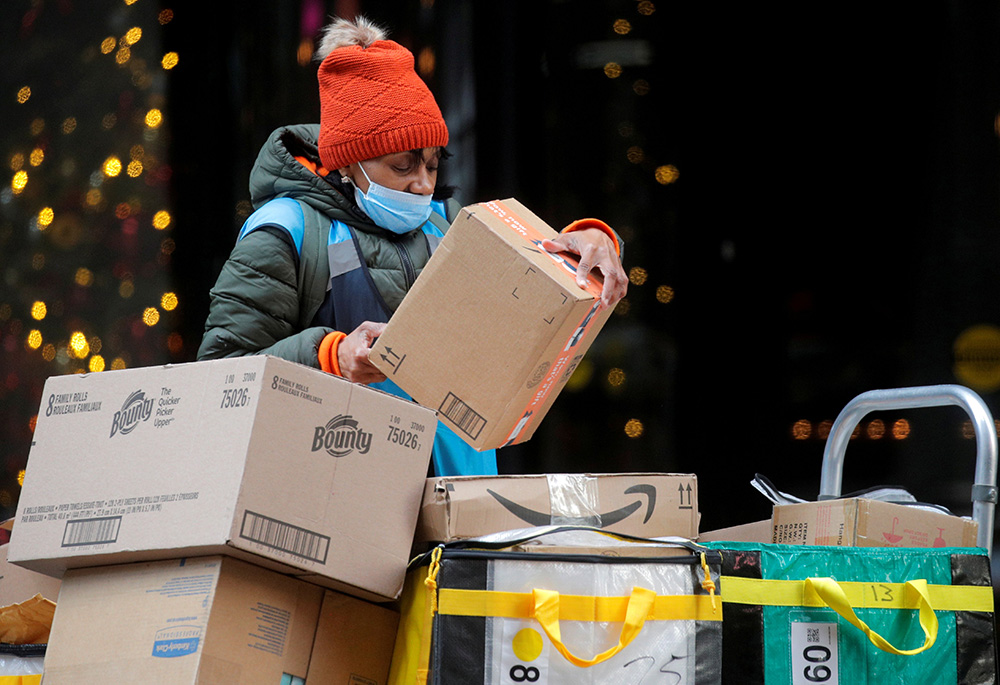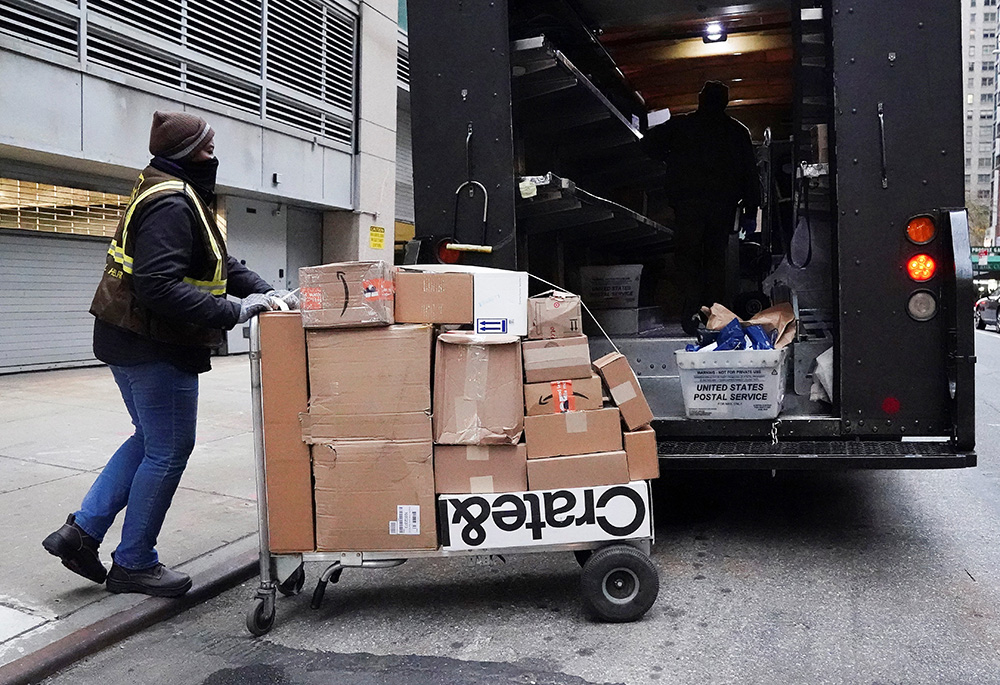
An Amazon delivery worker in New York City stacks boxes on Cyber Monday Nov. 29, 2021. (CNS/Reuters/Brendan McDermid)
Do you still have one or two unwanted Christmas presents lying around your house? Perhaps you purchased a gift to support your New Year's resolution, but two weeks into January, you've already decided otherwise.
As we make our way through the first month of 2022, we may have plans to make a happy return and exchange on these unwanted gifts, to start the year afresh and uncluttered. Retailers and mailing services anticipate our decluttering plans, as many returns occur during the month of January, according to the National Retail Federation (NRF). And last year, UPS even dubbed the first week of January "National Returns Week."
In a world of excess, it's common to receive gifts that don't quite suit us, whether it's a sweater that's the wrong size, a shirt we already own or a vase that just doesn't match our style. It's become common practice for gift-givers to include a gift receipt with a present, to avoid such a faux pas and as a courteous fail-safe to ensure that an unsavory gift can be easily returned. And as e-commerce continues to dominate, businesses have adopted a similar ethos, with many online retailers guaranteeing free returns.
But despite the purgative convenience for consumers, returns — whether in-person or online —bear startling environmental costs. We as consumers, citizens and people of faith must reckon with these costs, in the hopes of approaching our "stuff" in a new light.
Every year, Americans return about 3.5 billion products, according to The Guardian. As NRF detailed, in 2020 alone, U.S. retailers accepted returns totaling more than $100 billion in merchandise sold online.
But where do these returns go?
We might assume that our returns are cheerfully restocked in their respective store shelves. In truth, returns take a different, albeit more complicated, journey — one that has been explored recently in a number of news reports.

(Unsplash/Nathan Lemon)
Writing for The Atlantic this fall, Amanda Mull noted that "stores like Neiman Marcus and Target, which carry a bunch of different brands, are often able to return excess product to those brands for at least a partial refund." From there, the brand or wholesaler who originally supplied the product is responsible for making use of the returned stock. Larger retailers like Amazon offer online marketplaces to repurpose these returns, CNN Business reports, as does Walmart, which also resells returned items in their brick-and-mortar clearance sections.
Another article from The Atlantic reported that other returns are purchased by liquidation warehouses, where they are sorted, listed on liquidation marketplace websites and then sold to additional resellers. In some cases, as CNN reported, retailers like Macy's have their own resell stores while other products end up for sale online by small entrepreneurs.
But not every return has as happy a fate.
Advertisement
Speaking to The Atlantic, consulting firm director Joel Rampoldt said the retail industry believes about 25% of returns are discarded, although it varies depending on the product. Clothing, which has a startling return rate of 40-50%, according to The Guardian, can be easier to resell, though reseller practices differ there, too. As The Atlantic reported, "Many retailers don't allow any opened product to be resold as new," and some items, like beauty supplies and swimsuits, "are destroyed for sanitary reasons" altogether.
Jason Goldberg of the communications firm Publicis told CNN Business that destroying returns "in the best case means recycled, but often means ending up in a landfill or literally burned."
Such a revelation may shock consumers who are unfamiliar with destructive retail practices, whether it's companies like Old Navy, Hallmark and Urban Outfitters requiring employees to destroy items before discarding them, or luxury brands such as Burberry and Coach, the latter exposed by viral activist Anna Sacks (@thetrashwalker).
Such wasteful destruction, regardless of the reason, is unconscionable — and occurs in the case of returned products, too. Done well, return-to-resell processes require additional warehouse space, additional employees and further markdowns. Given that free returns already cost retailers billions, there may be little corporate incentive to invest in efficient processes to resell returned items. Faced with the overwhelming demands of sorting returns, retailers may find it easier, and even cheaper, to discard product than to reckon with it. This dysfunctional logic likely contributes to an estimated 5 billion pounds of retail returns discarded in landfill every year.
Convenience in our lives comes at a steep price, evidenced in the shocking working conditions of Amazon drivers delivering the company's two-day shipping promise, or the exploitation of vulnerable workers throughout the global supply chain.
In the case of returns, the costs are too great to be ignored, and are felt by worker, consumer and even retailer. Transporting returned items releases 15 million metric tons of carbon dioxide into the atmosphere, according to Optoro, a tech company specializing in merchandise returns. Discarded returns, as well as their packaging, overwhelm landfills, polluting land, water and neighboring communities.
Though some companies have taken some initial steps to reduce the environmental footprint of business practices, opting for zero-emissions delivery and electric delivery vans (as reported by The Verge), these movements are too few and far between, and ultimately fail to resolve the waste borne of returns, exacerbated by the rise of e-commerce.

A UPS worker in New York City transports packages on Black Friday Nov. 26, 2021. (CNS/Reuters/Carlo Allegri)
These ills impact the entire human community and jeopardize living conditions for vulnerable populations. They are, in short, too great to be ignored.
Here, we come to face what Pope Francis calls the "throwaway" cultural mindset in action. Ecosystems are subordinated to our economic desires, and the health of the natural world is sacrificed for the sake of convenience.
The words of Ecumenical Patriarch Bartholomew give pause to the overconsumptive faith practitioner: "for humans to contaminate the Earth's waters, its land, its air, and its life with poisonous substances — these are sins." Here, consumers contribute, perhaps unwittingly, to ecological sin, defined by the Vatican's Synod of Bishops for the Amazon as "acts and habits of pollution and destruction of the environmental harmony." These "sins," whether borne of retail returns or another mundane pursuit, must be confronted by people of faith.
In his encyclical "Laudato Si', on Care for Our Common Home," Pope Francis urges the faithful to "become painfully aware" of our present situation, and in doing so "dare to turn what is happening to the world into our own personal suffering and thus to discover what each of us can do about it."
So, what should the conscious consumer do with the too-small sweater, the duplicate shirt, the tacky vase? How can we relieve ourselves of the thoughtful, but unwanted, gifts we received this past holiday season?
Ultimately, the "greenest" gift we can give is less.
One solution is to simply regift the item. Through regifting, we can pass along our unwanted wares while bringing delight to a family member, friend or neighbor. Groups like the Buy Nothing Project offer avenues to connect with neighbors, meet needs in the community and become reacquainted with the subtle art of regifting. We might also resell the item ourselves through Facebook Marketplace or online resale applications like eBay, Poshmark and Mercari — though this might best be done in consultation with the gifter, so not as to offend.
But regifting and reselling are no panaceas. Whether we find our unwanted items a suitable home or not, the threat of waste remains. There exists a need for us to re-envision our relationship to gifting, and how we give (and receive) in future scenarios. We can consult with family and friends and suggest gifting in "greener" ways, such as consigning gifts or purchasing from secondhand stores. We can also endeavor to gift services and presents that will "break down," such as edible products, eco-friendly soaps and other items.
Ultimately, the "greenest" gift we can give is less.
Distancing ourselves from the allure of overconsumption may prove difficult, especially during the holiday season, but proves environmentally prescient. And removing hyper-consumptive expectations from our interpersonal relationships may even strengthen them, releasing our bonds from social pressures surrounding gifting and redirecting our focus toward the intangible gifts found and forged in our connection with others.
The dysfunctional state of retail returns, though bleak, should motivate us to re-envision our gifting practices, and challenge the industries we support daily.




